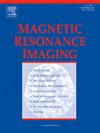适当强度的加速度选择性运动敏化梯度用于非触发、非对比增强的下肢磁共振血管造影。
IF 2
4区 医学
Q2 RADIOLOGY, NUCLEAR MEDICINE & MEDICAL IMAGING
引用次数: 0
摘要
非对比增强磁共振血管造影(MRA)对外周动脉疾病的诊断非常有用,尤其是对肾功能不全的患者。最近,采用加速选择性运动敏化梯度(as - msg)的非触发、非对比增强MRA被引入,称为增强加速选择性动脉自旋标记(eAccASL)。我们的目的是研究AS-MSG在下肢应用该技术时的合适强度。四种加速编码(AENCs)的非触发eAccASL;与心电图(ECG)触发的eAccASL (AENC: 0.87 m/s2)相比,分别为0.17、0.29、0.58和0.87 m/s2)。在流模中,计算信号强度(si)。非触发型eAccASL的SI较高,AENC较小。在8名志愿者中,计算了血管背景对比(vbc),并由两名放射科医生评估了动脉可见性和静脉伪影。非触发型eAccASL患者VBC较高,AENC较小。未触发的eAccASL 0.87比ecg触发的eAccASL 0.87在腓骨动脉和胫骨前后动脉的vcs低(p均 2被认为适用于使用eAccASL进行非触发、非对比增强的下肢MRA)。本文章由计算机程序翻译,如有差异,请以英文原文为准。
Appropriate strength of acceleration selective-motion sensitized gradient for non-triggered, non-contrast enhanced magnetic resonance angiography of the lower extremities
Non-contrast enhanced magnetic resonance angiography (MRA) is useful for diagnosing peripheral arterial disease, especially in patients with renal insufficiency. Recently, non-triggered, non-contrast enhanced MRA using acceleration selective-motion sensitized gradient (AS-MSG), known as enhanced acceleration-selective arterial spin labeling (eAccASL), has been introduced. We aimed to investigate the appropriate strength of the AS-MSG for this technique in the lower extremities. Non-triggered eAccASL with four acceleration encodings (AENCs; 0.17, 0.29, 0.58, and 0.87 m/s2) was compared with electrocardiography (ECG)-triggered eAccASL (AENC: 0.87 m/s2). In the flow phantom, signal intensities (SIs) were calculated. A higher SI was observed with a smaller AENC on non-triggered eAccASL. In eight volunteers, vessel-background contrasts (VBCs) were calculated, and arterial visibility and venous artifacts were assessed by two radiologists. A higher VBC was observed with a smaller AENC on non-triggered eAccASL. The VBCs of non-triggered eAccASL 0.87 were lower than those of ECG-triggered eAccASL 0.87 in the peroneal, and anterior and posterior tibial arteries (all p < 0.05). Subjective scores for arterial visibility did not differ, with median scores within acceptable levels. The venous artifacts score of non-triggered eAccASL 0.17 was lower than those of non-triggered eAccASL 0.29, 0.58, and 0.87 and ECG-triggered eAccASL 0.87 (p < 0.01, p < 0.05, p < 0.001, and p < 0.01, respectively). In two clinical patients, arterial visibility on non-triggered eAccASL 0.29 was comparable or superior to that on ECG-triggered eAccASL 0.87. An AENC of 0.29–0.58 m/s2 was considered appropriate for non-triggered, non-contrast enhanced lower-extremity MRA using eAccASL.
求助全文
通过发布文献求助,成功后即可免费获取论文全文。
去求助
来源期刊

Magnetic resonance imaging
医学-核医学
CiteScore
4.70
自引率
4.00%
发文量
194
审稿时长
83 days
期刊介绍:
Magnetic Resonance Imaging (MRI) is the first international multidisciplinary journal encompassing physical, life, and clinical science investigations as they relate to the development and use of magnetic resonance imaging. MRI is dedicated to both basic research, technological innovation and applications, providing a single forum for communication among radiologists, physicists, chemists, biochemists, biologists, engineers, internists, pathologists, physiologists, computer scientists, and mathematicians.
 求助内容:
求助内容: 应助结果提醒方式:
应助结果提醒方式:


